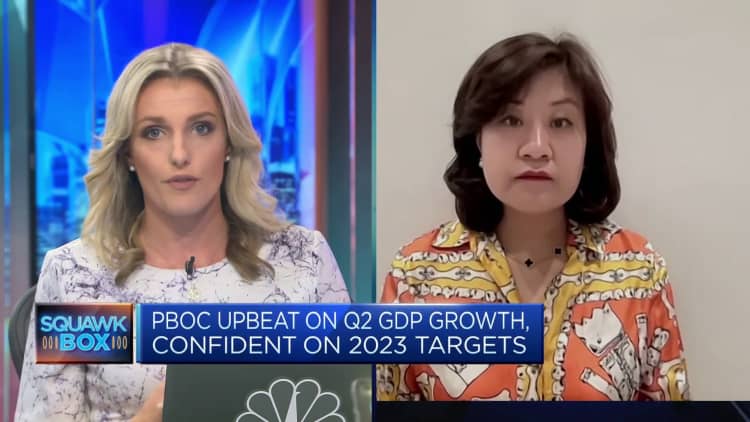China opens a new era of ‘proactive easing’ as the economic recovery turns sour
SHANGHAI, CHINA – NOVEMBER 04, 2022: Buildings at Lujiazui Financial District are illuminated to celebrate the opening ceremony of the 5th China International Import Expo (CIIE) on November 4, 2022 in Shanghai, China.
Vcg | Visual China Group | Getty Images
A central bank move in Beijing this week is being seen by economists as a starting gun on a new era of monetary policy as China’s Covid-19 reopening fails to gather pace.
On Tuesday, the People’s Bank of China cut its seven-day reverse repurchase rate from 2% to 1.9% — the such first cut in nine months — as the economy loses momentum and hard data starts to disappoint. Top China economists at Wall Street banks viewed the move as the start of much more easing to come.
related investing news


“This is the first cut since August 2022, and confirms further that policymakers have switched to proactive easing from wait-and-see,” Citi economists, led by Xiangrong Yu, said in a Tuesday research note shortly after the PBOC’s announcement.
“Our thesis of timely easing is playing out, and more measures of small steps that don’t have a high threshold could follow in coming weeks,” they said, adding that the upcoming July Politburo meeting in Beijing would be closely watched for more significant measures to follow.
China’s sovereign bonds rose in price following the latest move by the central bank while the Chinese yuan dipped to its weakest levels since November.

Pointing to soft economic figures from China, including credit data, Citi economists said “stimulus seems to be underway with the weak readings.”
China’s new bank loans for the month of May rose by 11.4% to 1.36 trillion yuan ($190 billion), missing estimates from a Reuters poll and strengthening the case for further stimulus, as the economy continues to see tumbling industrial profits on soft demand and falling exports.
Barclays economists, writing in a Tuesday note titled “Entering a rate cut cycle,” predict China will deliver a cut for every quarter until early 2024. The bank predicts a 10 basis-point cut in the medium-term lending facility rate on Thursday, as well as a cut to its loan prime rate next week (two monetary levers the PBOC uses).
“In the next nine months, based on our economic analysis and reasoning, we now expect the central bank to continue its monetary easing cycle with additional 30bp [basis point] policy rate cuts in total, 50bp RRR cuts and 60-80bp mortgage rate cuts for both new and existing home loans,” Barclays economists led by Jian Chang said in a note.
Goldman Sachs economists including Hui Shan said the firm expects the central bank to cut its medium-term lending facility rate on Thursday and its loan prime rate by 10 basis points next week. China’s central bank controls the benchmark one-year lending and deposit rates, which affect the borrowing costs for banks, businesses and individuals across the country.
Noting that the PBOC has never never cut policy rates and the reserve requirement ratio in the same month before, Goldman Sachs economists expect a full RRR cut to be delivered in the third quarter of this year. The reserve requirement ratio refers to the amount of money that banks must hold in their coffers as a proportion of their total deposits.
Goldman Sachs also expects the PBOC to deliver another 25 basis point RRR cut in the third quarter of this year, their economists said, adding that the firm expects another cut in the final quarter as well.
“Sluggish activity growth, potentially weak credit extensions, and low confidence are the reasons behind this cut, in our view,” they said.
Is it enough?
Mizuho Bank’s Head of Economics and Strategy for Asia Vishnu Varathan argued that the latest actions from China’s central bank “does not cut it.”
“Markets were justifiably unimpressed as credit data details suggest a worrying private sector confidence deficit that is likely to diminish run-of-the-mill stimulus efforts,” he said.
He predicted a more significant plan would be necessary — at the risk of overshooting and harming stability in the economy.

“Save for a more comprehensive stimulus plan that may necessarily imperil financial stability, it looks like PBOC rate cuts may just not cut it,” Varathan said.
Societe Generale economists also said, “much more easing is needed, particularly fiscal backed by central gov funding.”
“However, the drip mode of easing – preferred by Chinese policymakers – may not be well suited to containing the mounting deleveraging pressure within the economy,” SocGen economists said.
For all the latest World News Click Here
For the latest news and updates, follow us on Google News.

